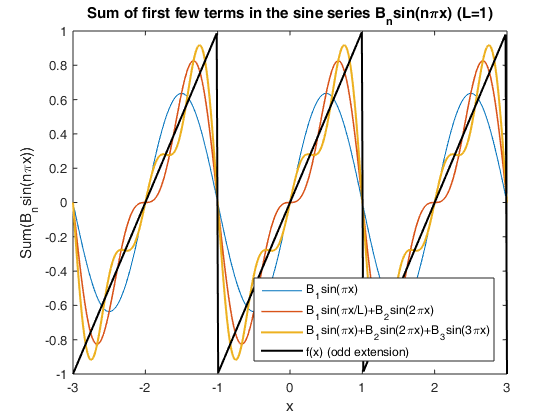Fourier sine series: sawtooth wave
Math 331, Fall 2017, Lecture 2, (c) Victor Matveev
Fourier series of a simple linear function f(x)=x converges to an odd periodic extension of this function, which is a saw-tooth wave.
clear; hold off L = 1; % Length of the interval x = linspace(-3*L, 3*L, 300); % Create 300 points on the interval [-3L, 3L] Const = -2*L/pi; % Constant factor in the expression for B_n Sn = 0; % Initialize vector sum series to zero for n = 1 : 3 Const = -Const; % Efficient way to implement alternating sign Bn = Const/n; % Coefficients inversely proportional to n Fn = Bn * sin(n*pi*x); % Calculate Fourier term Sn = Sn + Fn; % Add the term to Fourier sum plot(x, Sn, 'linewidth', n/2); % Plot the fourier sum hold on; end xlabel('x'); ylabel('Sum(B_nsin(n\pix))'); title('Sum of first few terms in the sine series B_nsin(n\pix) (L=1)'); plot(x, mod(x+1,2)-1, 'k-', 'linewidth', 1.5) % Tricky part of the code: generate saw-tooth wave legend('B_1sin(\pix)', 'B_1sin(\pix/L)+B_2sin(2\pix)', 'B_1sin(\pix)+B_2sin(2\pix)+B_3sin(3\pix)', 'f(x) (odd extension)', 'Location', 'Southeast');
